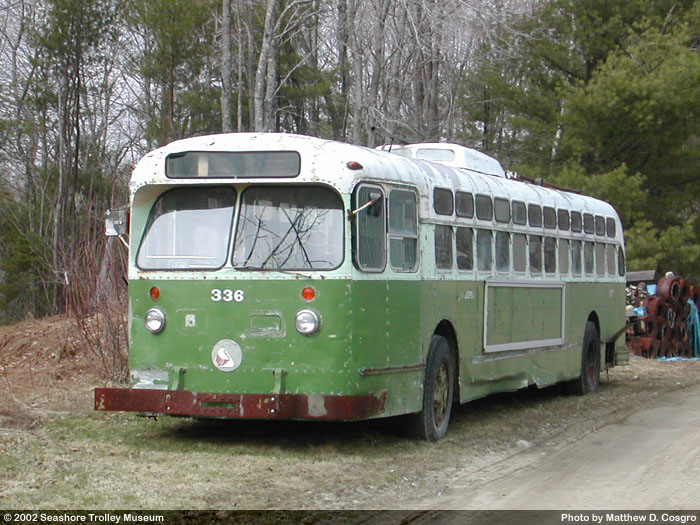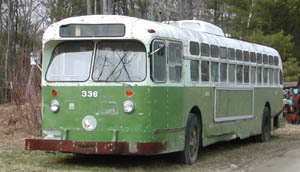
Matthew D. Cosgro
- Builder
- Marmon Herrington
- Description
- Model TC49
- Secondary Use
- None
- Type
- Trackless Trolleys
- Year
- 1955
- Retired from Service
- 1982
- Acquired by the Museum
- 1982
- Note
- No. 336 is stored outdoors.
- Fund
- 810
SEPTA 336
From Philadelphia, Pennsylvania
History
In 1923, Philadelphia opened the country’s first permanent transit line operated by trackless trolleys (also known as trolley buses). A few other cities had previously run these vehicles on a temporary, trial basis. Philadelphia continues to the present to use trolley buses on a few routes. In 1955, Philadelphia Transportation Company (PTC), which operated the city’s transit system, acquired 43 model TC-49 trolleybuses, Nos. 302 – 343, from Marmon-Herrington. The city government purchased the coaches which were, then, operated by PTC. These were the last new trolley buses for the city until 1980. PTC’s other Marmon-Herrington trolley buses were a group of model TC-46 coaches, Nos. 471 -498, acquired earlier in 1949. (The model number refers to the number of seats in the coach.)
The Marmon-Herrington Company was formed in 1931 to build trucks, including military trucks. It was the successor of the Marmon Motor Car Company which made luxury automobiles. Marmon-Herrington began building trolley buses in 1946. It became the largest post-war builder of trolley buses. The Marmon-Harrington trolley buses featured an innovative lightweight monocoque body where the body’s load is supported by its external skin. The company’s last order in the U.S. was Philadelphia’s purchase in 1955. It continued to build coaches for international customers until 1959. From 1946 to 1959, Marmon-Herrington produced 1,624 vehicles, all at the company’s Indianapolis factory.
In 1968, the Southeastern Pennsylvania Transportation Authority (SEPTA) took over the PTC’s transit operations. SEPTA continued to operate the 300 series trolley buses, using them on routes in northeastern Philadelphia. Most of the coaches, including No. 336, kept their green and cream PTC colors but with SEPTA lettering. In 1980, SEPTA replaced its trolley buses with new trolley buses from AM General.
In 1981, SEPTA conducted an auction to sell its retired trolley buses. Seashore placed a winning bid of $336 for No. 336. It came to the museum in 1982.
Technical Information
- Seats: 50
- Control: MRC
- Brakes: Straight Air
- Compressor: DH-10
- Tires: 11x22
Motor
- Number: 1
- Manufacturer: General Electric
- Model: 1213
Weight and Dimensions
- Length: 40’
- Width: 8’ 6.00"
- Height: 10’
- Weight: 20340 lbs.
Additional Images

Matthew D. Cosgro
© 1998 - 2025 New England Electric Railway Historical Society. All Rights Reserved.